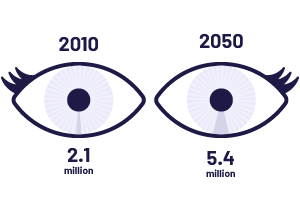
The National Eye Institute projects by the year 2050, 5.4 million people in the U.S. will suffer from Age-Related Macular Degeneration (AMD), more than double the number in 2010.
What is AMD?
AMD is a leading cause of blindness in the United States. The macula, which is in the back of the eye, controls our sharp, central vision. For some people with AMD, the macula gets weak slowly, with gradual vision loss, while for others with AMD, the growth of abnormal blood vessels causing blood and fluid leakage can lead to sudden vision loss in one or both eyes.
Who is at risk?
Age is a major risk factor for AMD. The disease is most likely to occur after age 60, but it can occur earlier. Other risk factors for AMD include:
- Smoking: Research shows that smoking doubles the risk of AMD
- Race: AMD is more common among Caucasians than among African-Americans or Hispanics/Latinos
- Family History and Genetics: People with a family history of AMD are at higher risk. At last count, researchers had identified nearly 20 genes that can affect the risk of developing AMD. Many more genetic risk factors are suspected.
Researchers have found links between AMD and some lifestyle choices, such as smoking. You might be able to reduce your risk of AMD or slow its progression by making these healthy choices:
- Avoiding smoking
- Exercising regularly
- Maintaining normal blood pressure and cholesterol levels
- Eating a healthy diet rich in green, leafy vegetables, and fish

Each eye represents a total of 80 million people, the estimated number of Americans who will be 65 and older in 2050, the population most affected by eye disease.
The early and intermediate stages of AMD usually start without symptoms. Only a comprehensive dilated eye exam can detect AMD. During the exam, your eye care professional will look for drusen, which are yellow deposits beneath the retina. Most people develop some very small drusen as a normal part of aging. The presence of medium-to-large drusen may indicate that you have AMD. If you are at risk for AMD because of age, family history, lifestyle, or some combination of these factors, you should not wait to experience changes in vision before getting checked for AMD.
If AMD reaches the most advanced stage, the focus of treatment shifts to vision therapy with a Low Vision specialist. Currently there is no way to reverse advanced AMD though there are clinical trials currently underway in medical, surgical, and stem cell research. Treatment is usually geared toward slowing the progression. Some treatment options include:
- AREDS2 vitamin supplements
- Dietary changes
- Injections of anti-vascular endothelial growth factor (anti-VEGF) medications
- Retinal laser
Harvard Eye Associates offers these and many other treatments. Visit our AMD page to learn more about the disease and your treatment options.
Source: The National Eye Institute




